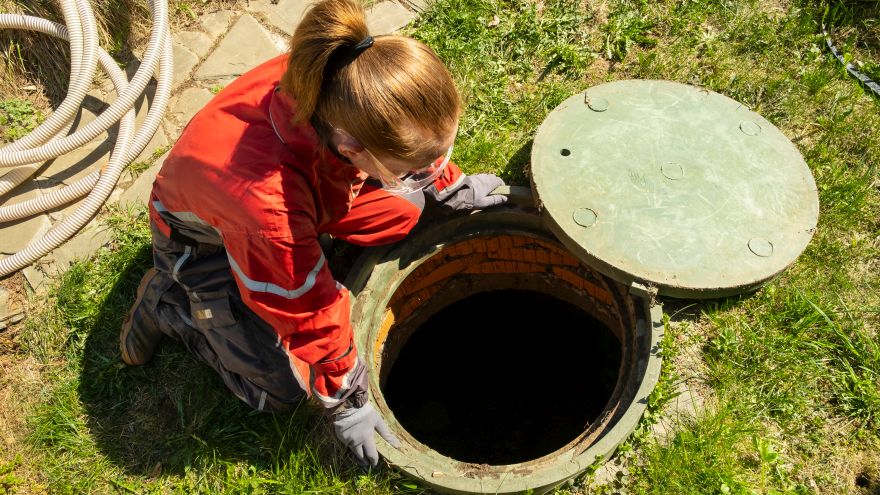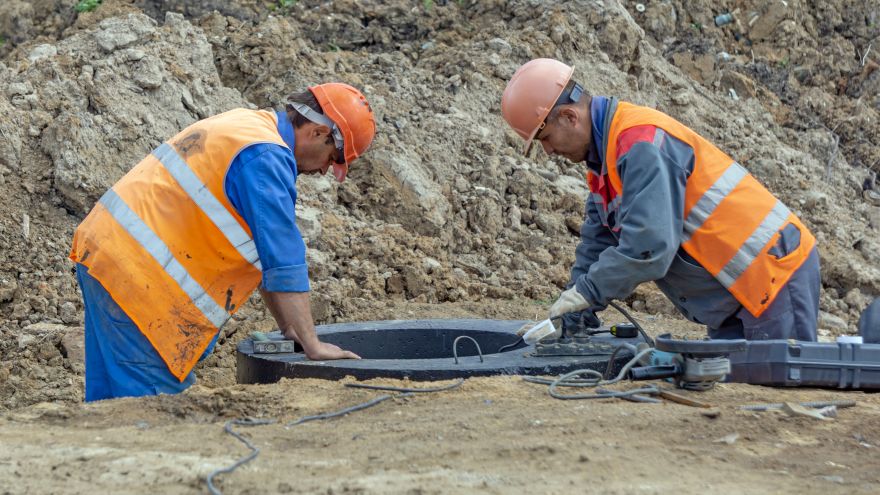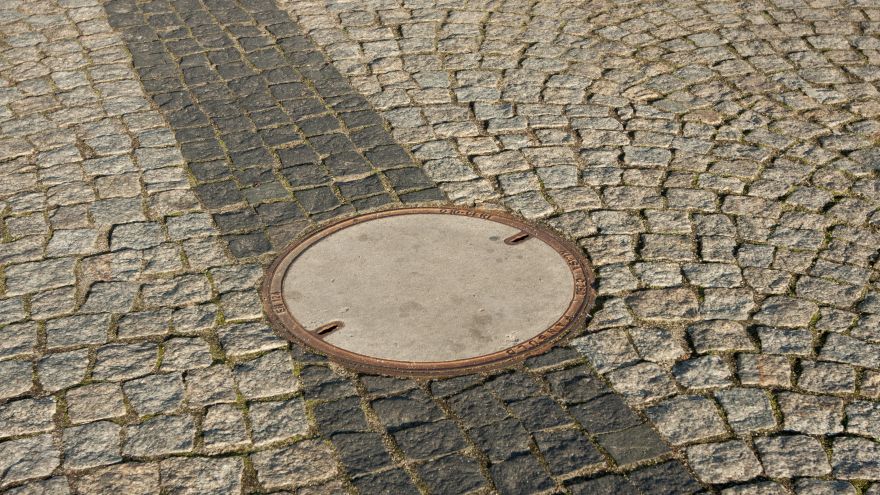Sewage wells are used to perform operational work in sewage channels, inspect these facilities, as well as to operate devices such as pumps and water meters. They are usually made of concrete, but sewage manholes made of durable plastics are becoming more and more popular. In the past, they were used primarily on properties, but now they are also used as part of investments by water and sewage companies.

Sewerage manholes – types and applications
Sewerage wells are used in sanitary (sewage), rainwater, combined sewage, drainage and industrial sewage systems. They are divided into manholes and non-manholes. The former usually allow entry inside, the latter do not, and are used for inspection purposes - for inspections and searches using appropriate devices.
Generally speaking, a sewage manhole is used for operational work, such as cleaning, inspection, rinsing or taking measurements. Manholes of this type differ in material, construction and purpose. In terms of application, they can be divided into:
- through - for inspection or changing the direction of sewage flow,
- collective (nodal) – placed at the intersection of channels, they maintain the appropriate flow of sewage
- with an inlet – they allow you to connect a new section of the sewage system, they can also be plugged,
- sedimentation tanks – used in rainwater drainage systems, they prevent rainwater from accumulating near the drain,
- cleaning – used where rainwater is managed,
- cascading – used for large differences in ground height,
- expansion wells - in places of large slopes, they limit the number of cascade wells,
- energy-intensive – in places with tectonic risk,
- tanks in sewage pumping stations - where sewage is removed under pressure,
Check your external sewage now at the Onninen wholesaler
Sewage wells are usually made of materials such as:
- concrete,
- stoneware,
- polyester resin,
- plastics - thermoplastics (polyethylene, polypropylene and, in addition to other materials, polyvinyl chloride) and glass fiber reinforced (GRP).
 Sewer wells can be segmented or monolithic. The first ones are usually made of concrete, the second ones can be made of concrete with a base, made of permanently connected plastic elements or made of polymer concrete, where the components are glued with resins.
Sewer wells can be segmented or monolithic. The first ones are usually made of concrete, the second ones can be made of concrete with a base, made of permanently connected plastic elements or made of polymer concrete, where the components are glued with resins.
The structure of a sewage well consists of:
- base – enabling connection of sewage pipes,
- shaft – with a diameter of 315-600 mm, or a chamber made of modular PP rings (polypropylene) with manhole steps (inner diameter 800-1000 mm,
- reduction cone – for correcting the height of the manhole,
- telescope – compensates for settlement, also allows for height correction, mounted at a depth of up to 0.8 m from ground level.
Check your external sewage now at the Onninen wholesaler
Requirements for high-quality sewer wells
High-quality plastic inspection chambers and others should be manufactured in accordance with a number of standards. The basic ones include PN-EN 13598-1 and PN-EN 13598-2 describing plastic pipe systems for underground non-pressure drainage and sewage - unplasticized polyvinyl chloride (PVC-U), polypropylene (PP) and polyethylene (PE). The first part contains specifications for auxiliary fittings and shallow manholes for structures subject to loads only from pedestrian traffic and with a depth of no more than 2 m.
The second part presents the specifications of manholes and inspection wells for facilities with road traffic loads and a depth not exceeding 6 m . Additionally, sewage wells compliant with these standards must also comply with the requirements of PN-EN 476 . According to it, non-entry manholes must have a diameter of at least DN/OD200, and manholes must have a minimum diameter of DN/ID800, and if they are adapted for personnel entry - at least DN/ID1000.
The PN-EN 124:2015 standard applies to the tops of inlets and sewage manholes for surfaces for pedestrian and vehicular traffic (with construction rules, type testing, marking and quality control). PN-EN 476:2011 contains general requirements for components used in gravity sewage systems. In turn, the PN-EN 681-1:2002 standard contains requirements for seals for water supply and drainage pipe joints (elastomer seals).
The PN-C-89224 standard was created due to the difficulties in referring to basic standards. It explains in detail the terminology related to plastic sewage manholes. It also consolidated the requirements of the PN-EN 476 standard and safety issues contained in the withdrawn but still applicable PN-B 10729 standard. Additionally, it organizes terms and definitions describing plastic pipe systems.
The high quality of the manholes can also be confirmed by certificates, e.g. from the German MFPA Institute or the Dutch KIWA Institute, technical approvals or National Technical Assessments.
Advantages of plastic sewage wells
 Plastic wells are 18 times lighter than their concrete counterparts and are much cheaper to operate . The smooth internal surface and profile of the base mean that there are practically no blockages in them, and maintenance activities, e.g. cleaning, are easy to perform. Prefabrication provides them with perfect hydraulics, assembly is easier and takes less time . It is also cheaper due to the ease of moving their elements and entire structures. Their external dimensions are smaller than those of concrete wells, which, combined with a much lower weight, simplifies installation and connects them to pipes more conveniently. The foundation does not require large excavations. Its width is only to enable compaction of the backfill around the well (min. 150 mm). An additional advantage is a wide selection of prefabricated elements as well as inlet diameters and angles.
Plastic wells are 18 times lighter than their concrete counterparts and are much cheaper to operate . The smooth internal surface and profile of the base mean that there are practically no blockages in them, and maintenance activities, e.g. cleaning, are easy to perform. Prefabrication provides them with perfect hydraulics, assembly is easier and takes less time . It is also cheaper due to the ease of moving their elements and entire structures. Their external dimensions are smaller than those of concrete wells, which, combined with a much lower weight, simplifies installation and connects them to pipes more conveniently. The foundation does not require large excavations. Its width is only to enable compaction of the backfill around the well (min. 150 mm). An additional advantage is a wide selection of prefabricated elements as well as inlet diameters and angles.
Thanks to its low weight, the use of heavy equipment is limited during installation, and there is no need to build access roads . The wells are completely tight , therefore resistant to groundwater infiltration and do not allow sewage to enter the ground. The plastics from which the manholes are made have high strength parameters, and the appropriate design facilitates inspection and provides resistance to groundwater uplift. They can be used in changing climatic conditions.
They are resistant to sulphate corrosion and harmful chemicals found in sewage systems, and they also have a long life - more durable than concrete ones .
This type of wells are suitable for many applications. Depending on the selected model, they can be used to build gravity sewage or drainage networks. Those with "blind" bases are used as tanks and in sewage pumping stations. They are perfect for use on private properties .
At the Onninen wholesaler you can purchase high-quality solutions for the construction of sewage wells:
- Telescopic pipes - have special hooks and are intended for the Diamir series of wells.
- Wavin DN600 corrugated polyethylene shaft pipes - durable pipes from the Tegra series. The orange color may be helpful during installation - the pipes are visible from a distance.
- Wavin pass-through box 315/160 mm – intended for a smooth 160 mm inlet pipe or a 315 mm corrugated riser pipe. Made of durable polypropylene. It has a profiled bottom and a muff connection.
- Wavin flow units for advanced Tegra wells adapted to the most difficult soil and water conditions - the product is intended for Tegra wells: which are among the most advanced plastic sewage wells and allow service personnel to enter. The wall lamp is made of polypropylene, it is durable and easy to install.
- Telescopic covers – high-quality covers, characterized by high resistance to low and high temperatures. The materials used mean that the cover discolors more slowly under the influence of weather conditions and is highly resistant to pressure.
Check your external sewage system now at the Onninen wholesaler